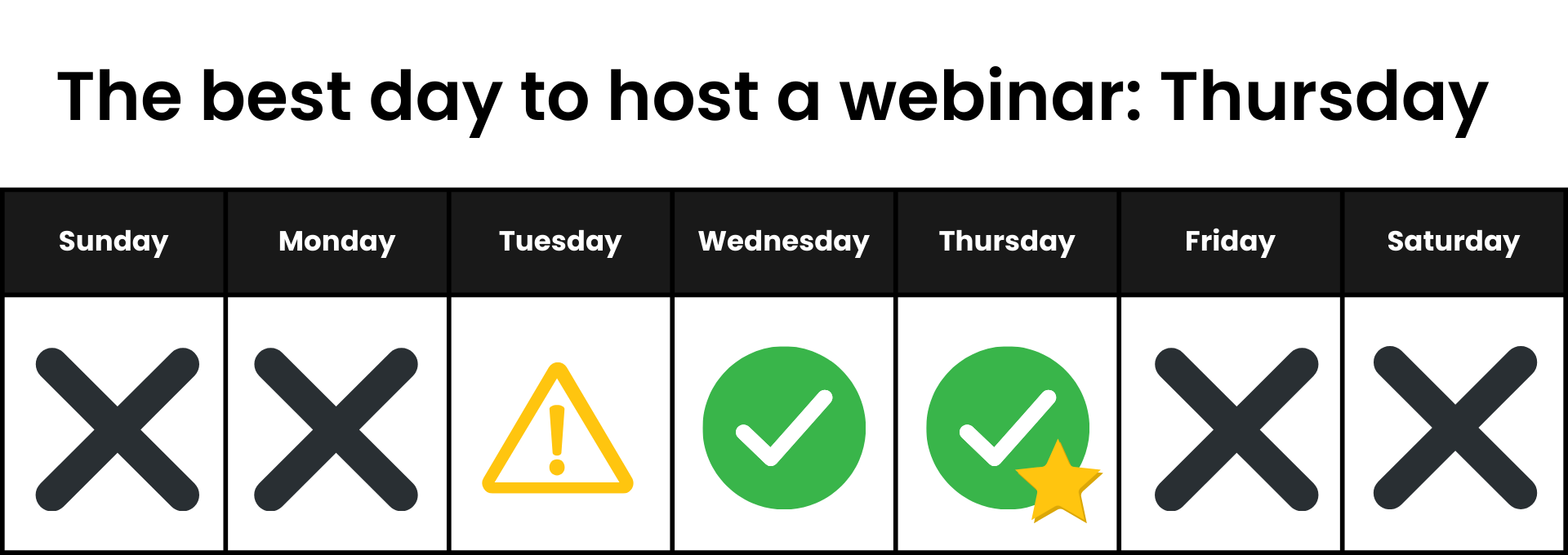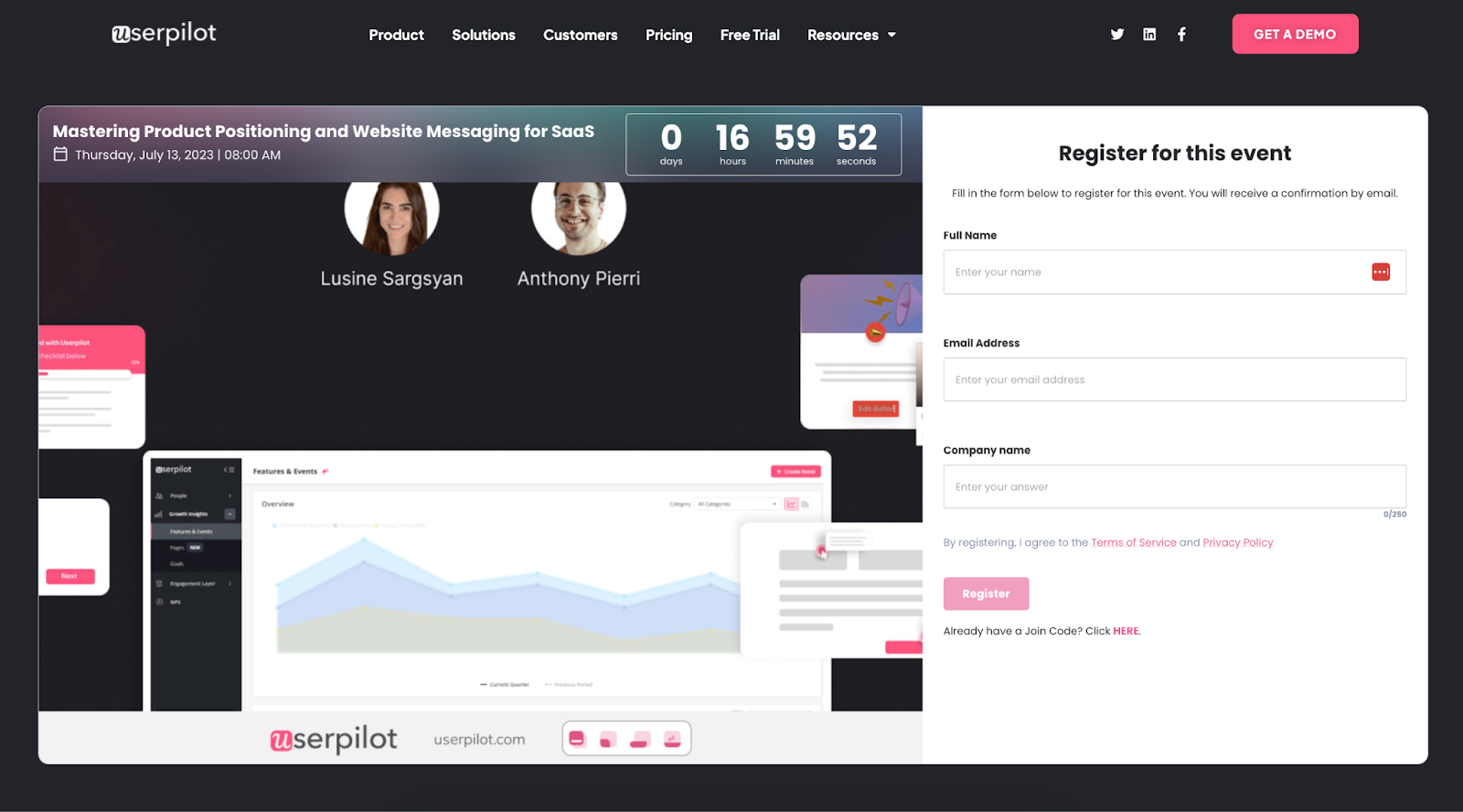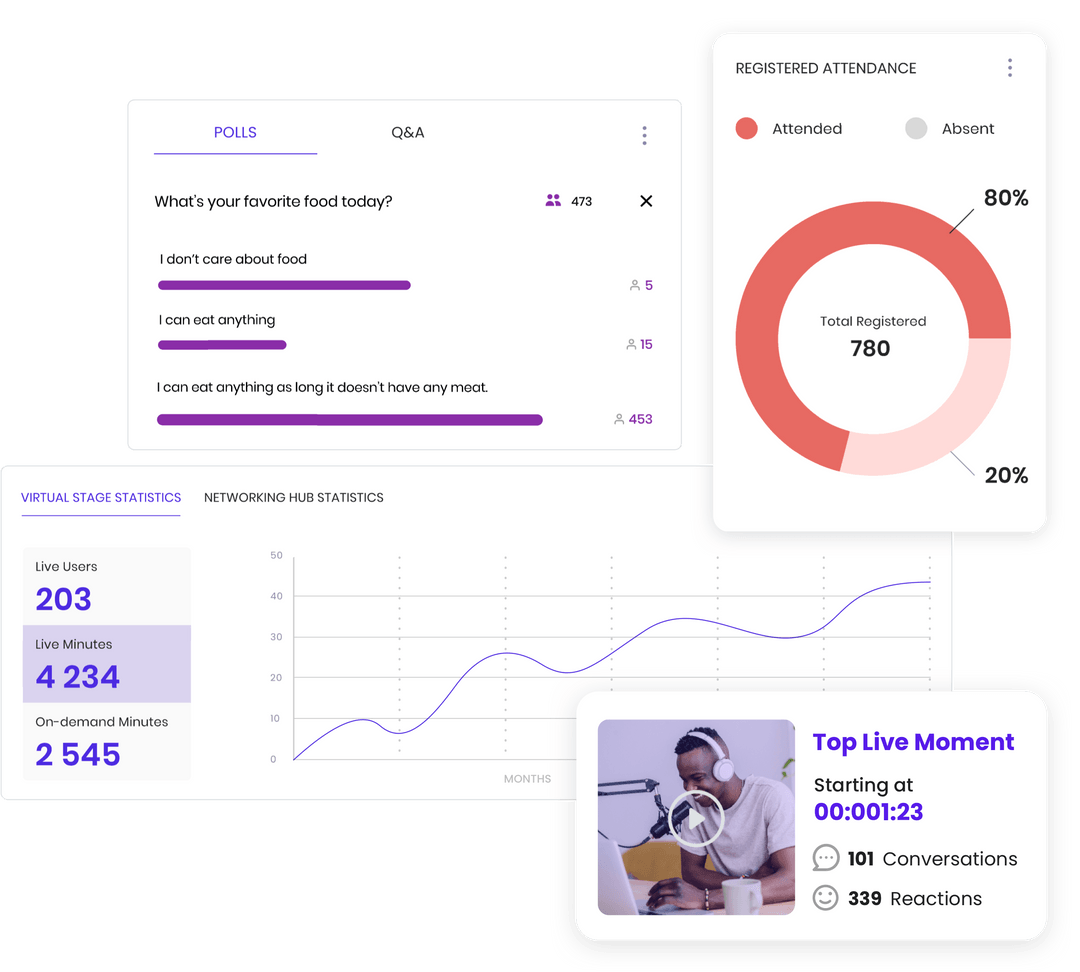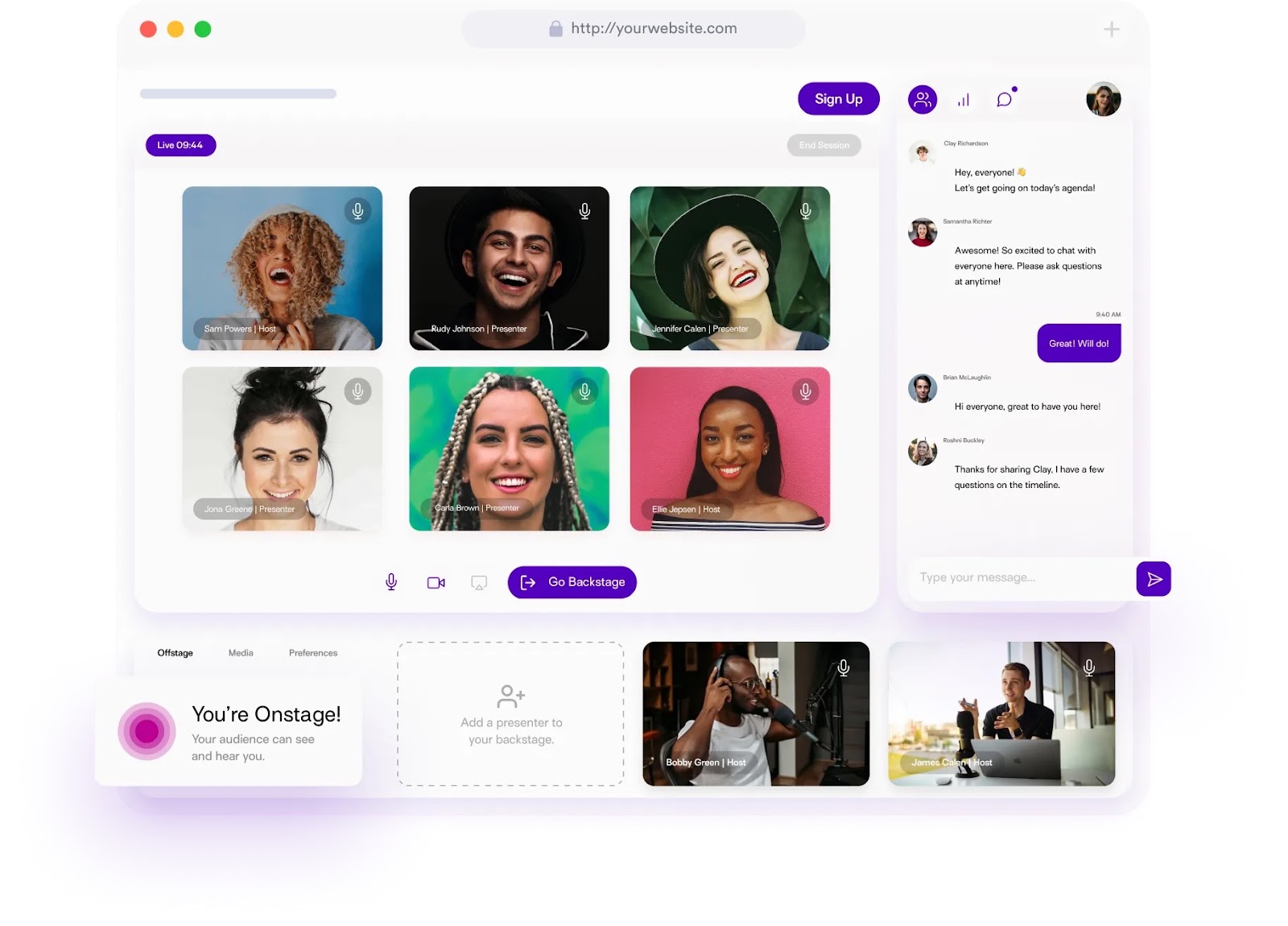Webinar Timing Secrets: Uncovering the Best Time for Webinars
When orchestrating a stellar webinar, multiple variables come into play – content creation, tech-setup, promotion strategy, and true to the saying “timing is everything”, zeroing in on the perfect schedule. Selecting the right timing can significantly impact attendance rates and the overall success of your online event.
But how do you settle on the best time for webinars? And doing so, considering both global and local demographics! We’ll help you determine the days proving most fruitful but also specific hours that’ll ensure maximum turnout. Here’s everything we’ll cover:
- Factors that Affect the Webinar Time
- What are the Best Days to Host a Webinar?
- What is the Best Time to Host a Webinar?
- Tools and Techniques to Determine the Best Time for Your Webinars
- How Long Should a Webinar Be?
- Eight Tips to Maximize Webinar Attendance
- Webinar Timing and Content Value are Everything
Keep reading for fact-backed insights from studies conducted on audience behaviors and preferences related to webinars.
Factors that Affect the Webinar Time
The key to pinpointing the best time for webinars hinges upon several critical factors. To ensure high attendance, these factors must be considered when planning your webinar schedules.
Your Audience & Demographics
Your target audience plays a significant role in determining the ideal webinar timing. Specifically, their demographic information forms an essential part of this decision process.
Consider aspects like age group, nature of occupation, and lifestyle habits which can influence their availability. For example, if you are targeting working professionals, they might prefer webinars scheduled during lunch breaks or after work hours. On the other hand, a student or retiree would be more receptive to mid-morning slots as it avoids school hours and peak hustle and bustle periods respectively.
Time Zones and Jobs
The geographical spread of your potential attendees is another crucial factor when deciding the best time for a webinar. If your audience is primarily located in one specific region or time zone, then scheduling becomes somewhat straightforward. However, global audiences pose additional challenges given their wide distribution across varying time zones.
Take into account their place of residence and possible work timings while zeroing in on a prospective slot. Make an effort to schedule the session considering multiple zones so that it doesn’t inconvenience the majority of your audience who may be at work or asleep during that period.
Holidays & Events
Lastly, avoid clashing with public holidays and major events within specific regions you’re catering to. Holidays such as Christmas or New Year’s Eve are usually reserved for family gatherings hence interfering with these festivities might lead to poor turnout for your webinars.
Similarly, watch out for widely celebrated observances including local festivities which vary from country to country depending on where you’re based – Thanksgiving Day (US), Diwali (India), or Golden Week (Japan).
Moreover, plan around mega events like the Super Bowl, World Cup final match days, etc which could whisk away vast portions of your prospective attendees leading to dwindling viewer counts despite having determined what seemed like the perfect time slot otherwise.
Though seemingly minor details, prioritizing understanding your viewer’s background can greatly unravel previously undiscovered avenues thereby optimizing participation rates! After all, finding just the right timing matters enormously when engaging in virtual interactions via webinars!
What are the Best Days to Host a Webinar?
Effective webinar hosting requires careful thought not just towards content, but timing as well. The best days for webinars are those that ensure maximum attendance. A small factor like the day of the week can indeed have a significant effect on your webinar attendance rate.

Schedule Webinar on Mid-Week
Choosing to host your session during mid-week, preferably Wednesdays and Thursdays, is an ideal way to significantly boost your audience turnout. Why is that so? Let’s take a closer look:
- Business Flow: By Wednesday, most employees and managers tend to catch up with pending tasks from the previous week and are in full swing with their current week’s projects. This makes them more relaxed and oriented towards learning new things.
- Work-life Balance: Additionally, people typically plan social events or family activities during weekends or around it; hosting webinars in the middle of the week helps you avoid clashing with your attendees’ personal commitments.
- Anticipated Fatigue: Monday blues exist! The first working day of the week often comes with its load of stress and pressure causing attendees fatigue which might reduce engagement levels in webinars conducted on this day.
Analysis from various industries indicates that Thursday is arguably the best day of the week to host a webinar judging from higher attendances recorded.
Avoid Hosting Webinars on Mondays, Fridays & Weekends
There are notable arguments against choosing Mondays and Fridays (or even weekends) as preferable days for webinars;
Let’s explore why these may not be suitable as the best time for webinars:
- Weekend Detachment: Many professionals disconnect entirely from work-related issues over the weekend; thus, they’re less likely to participate in professional development pursuits such as webinars.
- Beginning-and-End-of-Week Commitments: Pressure to either start or wrap up weekly tasks deters many potential participants from committing their time to attend webinars held on either Mondays or Fridays.
- Limited Spillover Time: Suppose an attendee wishes to reach out after attending your webinar for further discussions or clarifications; sessions planned very close to weekends limit this possibility.
Avoiding these days improves chances significantly when figuring out what could be the best times for a webinar.
While scheduling flexibility is essential considering global audiences in different time zones, finding ‘universal optimal points’ while setting dates would go a long way facilitating higher attendance rates – all elements held constant!
What is the Best Time to Host a Webinar?
Defining the best time for webinars entails an evaluation of numerous factors, which can range from demographics to geography. However, it’s imperative always to remember that making your webinar accessible across different time zones and being flexible with scheduling can yield greater results.
Ensure Your Webinar is Accessible in Different Time Zones
When planning your webinar schedule, considering the global reach of your audience becomes pivotal. The “best time” for webinars, thus, relies largely on ensuring maximized accessibility across various locations worldwide.
Merely focusing on local timing might exclude potential attendees residing in vastly different time zones. For instance, if you’re hosting your webinar at 5 p.m Pacific Standard Time (PST), then you’re essentially asking someone in Eastern Standard Time (EST) to tune in at 8 p.m and someone in Central European Time (CET) at 2 a.m – not quite an inviting prospect!
To increase participation by overcoming such spatial hurdles:
- Conduct multiple sessions: Hosting identical webinars at different time slots increases the likelihood that more participants will find a convenient one.
- Consider prime times globally: Aim for timing that hits ‘sweet spots’, where work hours align – like mid-morning or early afternoon in PST, which would be just about evening or late afternoon EST and CET respectively.
These steps might indeed make it less burdensome for international audiences looking to benefit from your content without struggling against inconvenient timings.
Offer On-demand Webinars
While figuring out what is the best time to host a webinar may seem slightly challenging due to varying geographic locations and schedules of participants, there’s another solution – offering on-demand webinars.
On-demand webinars allow viewers unable to attend live events due to scheduling conflicts or location differences to access them later at their convenience. This option gives them flexibility while also increasing the potential viewer base for your content significantly.
With no pressing need for real-time involvement, it can become a win-win! Attendees get comfortable viewing periods; hosts get higher engagement rates through replay views.
Both Userpilot’s webinar series and the Game Changers webinar series are great examples of how you can host webinars based on core audience engagement times yet make the replays easily accessible right after the session has ended. What’s nice about these examples is that the webinar recordings are instantly available so their audience can tune in even if they missed it by only a minute.

So even though determining when is the best time to host a webinar is important, try incorporating aspects that ensure inclusivity and provide convenience. Mastering these elements can amplify both participation rates and satisfaction levels amongst prospective attendees significantly.
Tools and Techniques to Determine the Best Time for Webinars
While studying traditional patterns helps in determining the best time for webinars, utilizing specific tools and approaches can provide data-driven insights. These solutions can help dissect your audience’s behaviors, preferences, or even their most active hours online within the context of your content.
Online Survey Tools to Poll Potential Attendees
One of the things I highly recommend is tapping into online survey tools as a technique to poll your potential attendees directly. Their input about preferred viewing times will be invaluable. Services such as SurveyMonkey or Google Forms offer platforms where you can easily compile questions, collect responses and perform basic analysis.
Releasing brief questionnaires at appropriate intervals will enable you to engage with your audience while simultaneously deriving critical information which defines when is the best time for a webinar in the eyes of your participants. However, if you are attempting to do this within your webinar experience, I would recommend using poll features that are native to your webinar tool.
Analysis of Past Webinar Attendance Data
Taking into consideration previous webinar attendance data can give key insights about what worked well and what didn’t, especially regarding timing.
The primary focus should be on understanding patterns in registration counts depending upon different dates and timings when you hosted past webinars. Such primary source data often presents the overall picture more clearly than secondary research ever could.
Remember that these statistics may vary over time especially if there’s shifts within your target population due to any marketing initiatives aimed at attracting new demographics.

Consider Social Media and Email Marketing Metrics
Using social media analytics along with email marketing metrics has proven useful in tracking user activity patterns thus helping determine the best times for webinars. Most social networks provide comprehensive behavioral reports indicating peak interaction periods throughout a typical day or week among other details.
Email open rates also establish high-activity windows wherein subscribers are more likely to engage with marketing material received – this information could act as a good measure towards deciding an ideal promotional schedule leading up to actual webinar broadcasts as well.
Do remember that these strategies aren’t substitutes but complementary elements woven together seamlessly uncovering the perfect slot fitting everyone’s convenience while maximizing reach & participation rates. Hence a data arsenal composed from diverse platforms brings richer insights around identifying optimal scheduling slots.
How Long Should a Webinar Be?
Understanding the optimum duration for your webinar is just as crucial as determining the best time for webinars. While there isn’t a one-size-fits-all answer, certain guidelines can steer you in the right direction.
Webinars typically range from 30 to 90 minutes. However, an ideal duration to aim for is between 45 to 60 minutes. This period allows for comprehensive topical coverage without risking attendee fatigue or boredom. Keep in mind that beyond this timeframe, it becomes challenging to maintain listener attentiveness and engagement.
However, exceptions exist. For instance, if you have engaging content or are hosting an intensive training session, running a longer webinar might be necessary. Similarly, short and concise webinars may work best when addressing simple topics or conducting product demonstrations.
- 30-minute webinars: These short yet impactful sessions are great when you need to cover straightforward topics precisely and swiftly.
- 45-60 minute webinars: The balance of depth and length makes this duration perfect for most subjects requiring detailed exploration.
- 90-minute and longer webinars: When conducted wisely with breaks built-in, these long-form webinars can provide immense value during extensive workshops or training sessions.
Remember: The central element here isn’t solely about getting the length “right.” Instead, consider whether your selected duration supports your content’s value adequately – matches audience’s expectations and stays consistent with your objectives. As important as figuring out the best day of the week to host a webinar or finding the sweet spot in terms of the best time of day for webinars might be, remember never to compromise on content quality over timing considerations!
Eight Tips to Maximize Webinar Attendance
Analyze Your Data
The first step in unearthing the best time for webinars is data analysis. Dive deep into your past webinar data, if you have any. Look at details such as what time of day saw the highest participation or which days had a better turnout. Understanding your audience’s behavior and preferences can give valuable insights.
Schedule in the Middle of the Week
One prominent suggestion for maximizing attendance is focusing on mid-week timings. Wednesdays and Thursdays are often considered the best days for webinars since potential attendees would have settled into their workweek rhythm by then.
Plan a Webinar at 11:00 a.m
If we delve further into specific times, 11:00 a.m seems to be favored by experts owing to several reasons. It pinpoints late morning when people often take breaks, are likely more engaged, and less inundated with other commitments compared to later in the day.
Pick a Time That Works in All Time Zones
Finding a suitable time that marries all time zones is crucial when you have an international audience. Ensure the selected timing is convenient across various geographical locations. This might require offering two sessions catering to different hemispheres.
Remember Time Differences
Bearing this in mind, it’s vital not only to pick a time that works across time zones but also taking daylight-saving differences into account. Ignoring these nitty-gritty elements could risk losing out on potential attendees who would otherwise be interested.
Host a Prerecorded Webinar
Another way around this timezone confusion and ensuring maximum attendance could be hosting prerecorded webinars naturally packaged as “on-demand.” This gives your audience flexibility allowing them to join whenever most convenient for them, thereby expanding your reach exponentially.
Tip: Use a webinar tool that allows you to host pre-recorded webinars as if they were live. This concept is called “simulive”. It allows you to continue to engage with your audience through polls & questions without having to be live in the hot seat.
Host Longer Webinars
Contrary to popular belief that shorter sessions work best, research shows longer ones often oozes more value leading to higher retention rates than quick sessions lacking depth. So don’t hesitate while planning detailed webinars; remember – content value matters!
Promote the Webinar
Promotion is key! No matter how well-planned or timed your webinar is, without effective promotion strategies like social media advertising or email campaigns, it won’t reach its full attendee capacity.
In essence, uncovering the “best time for webinars” mystery needs thorough planning and trial-and-error exercises based on solid data, acknowledging geographic variations among audiences while tying everything together with strategic promotional activities.
Tip: A great way to promote your webinar is via the speaker(s) themself. Get more exposure and tap into your speaker’s community by getting them to promote that they’ll be sharing their expertise in your webinar.

Webinar Timing and Content Value are Everything
Finding the best time for webinars is only one piece of the puzzle. The actual content you deliver during that webinar is equally (or more) essential for your success.
Remember, webinars aren’t just about ticking boxes or sticking strictly to a predetermined schedule. They’re about delivering high-value information in an engaging manner. Your audience will be more likely to stick around and participate actively if they’re receiving substantive material that speaks directly to their needs or problems.
It’s also important to remember that value isn’t restricted merely to the core informative content either. Valuable interaction could also mean polls, quizzes, downloadable materials alongside your presentation, and opportunities for questions and answers after your presentation finishes.

Here are some key areas where quality content can shine:
- Topic Selection: Choose a relevant topic – something that aligns with your audience’s interests or pain points while falling snugly within your expertise domain.
- Format Variations: Work on diverse engagement tactics like infographics, videos, guest speakers, questionnaires, etc., within your webinar framework.
- Consistent Delivery: Being consistent with your high-quality webinars at a specific “best time” makes you dependable in the eyes of attendees, boosting repeat attendance rates.
- Interaction Levels: Encourage participation wherever possible – maybe through moderated rounds of questions after every significant point or interactive games related to your topic.
- Post-Webinar Content Sharing: Share helpful follow-up resources such as transcriptions, video recordings, or even an infographic summarizing the main takeaways; facilitating continued learning beyond the webinar hour.
Relevancy alongside timing — this powerful duo positions the final keystone spanning the arch of a successful webinar plan! Bear in mind though – there may never be ‘one perfect slot’ when considering what defines the best time for a webinar. It’s always going to be a calculated estimation based on several factors we’ve discussed earlier.
However optimal our chosen timing might be according to data insights or past trends analysis; maintaining good quality content delivered interactively should remain our uncompromising priority over mere ‘timing’ technicalities alone!
In revealing these webinar timing secrets today; I encourage you all not merely in seeking out what is considered statistically as the ‘best day of the week to host a webinar’ but taking equal ownership in master-crafting invaluable content and naturally distributing it across channels post-webinar too!
Conclusion
Planning a webinar might seem daunting at first glance. However, by deploying strategic approaches such as understanding your audience demographics, taking into account job schedules and various time zones, and avoiding inconvenient days like holidays or weekends, unraveling the puzzle becomes entirely feasible.
Experimentation is essential – even after finalizing what you think may be the best time of day for webinars. Consider scheduling events mid-week and preferably around 11:00 AM when most individuals are likely to be free. Remember that your primary goal should be maximizing convenience for attendees across all geographic regions. Offering on-demand or pre-recorded sessions could serve as ideal alternatives to live sessions.
So now that you’re equipped with all these secrets about scheduling webinars, it’s prime time you put them into practice and soar high in your next online event!